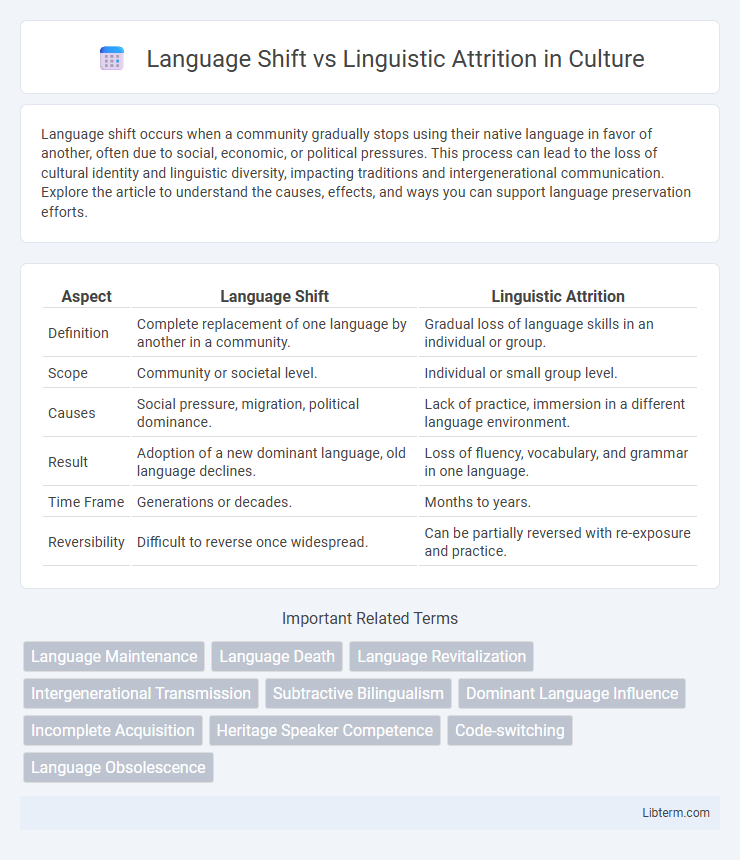Language shift occurs when a community gradually stops using their native language in favor of another, often due to social, economic, or political pressures. This process can lead to the loss of cultural identity and linguistic diversity, impacting traditions and intergenerational communication. Explore the article to understand the causes, effects, and ways you can support language preservation efforts.
Table of Comparison
| Aspect | Language Shift | Linguistic Attrition |
|---|---|---|
| Definition | Complete replacement of one language by another in a community. | Gradual loss of language skills in an individual or group. |
| Scope | Community or societal level. | Individual or small group level. |
| Causes | Social pressure, migration, political dominance. | Lack of practice, immersion in a different language environment. |
| Result | Adoption of a new dominant language, old language declines. | Loss of fluency, vocabulary, and grammar in one language. |
| Time Frame | Generations or decades. | Months to years. |
| Reversibility | Difficult to reverse once widespread. | Can be partially reversed with re-exposure and practice. |
Introduction to Language Shift and Linguistic Attrition
Language shift occurs when a speech community gradually adopts a new dominant language, often leading to the decline or loss of their original language. Linguistic attrition refers to the process where an individual or community experiences a loss in proficiency or fluency in a language previously acquired or used regularly. Both phenomena highlight the dynamic nature of language use and retention within multilingual and changing sociocultural environments.
Defining Language Shift: Causes and Consequences
Language shift occurs when a community gradually abandons its native language in favor of another, often due to social, economic, or political pressures such as migration, colonization, or forced assimilation. This process results in the loss of intergenerational transmission, leading to the decline of the original language within the community. The consequences include cultural erosion, identity transformation, and a reduction in linguistic diversity, impacting both individual speakers and societal heritage.
Understanding Linguistic Attrition: Key Concepts
Linguistic attrition refers to the gradual loss of a language by individuals or communities, distinct from language shift where an entire speech community adopts a new language. Understanding linguistic attrition involves examining factors such as reduced language use, decreased proficiency, and the influence of dominant languages on heritage language maintenance. Key concepts include language decay in vocabulary, syntax, and pronunciation, often triggered by limited exposure and social pressures favoring the dominant language.
Factors Influencing Language Shift
Factors influencing language shift include social pressure, economic advantages, and intergenerational transmission patterns, which determine whether a speech community abandons its native language for another. Urbanization and globalization intensify exposure to dominant languages, accelerating the shift process. Educational policies and media representation also play crucial roles in either promoting language maintenance or facilitating shift.
Triggers and Types of Linguistic Attrition
Language shift occurs when a community gradually abandons its native language in favor of another, often due to socio-political pressures or economic benefits. Linguistic attrition, triggered by reduced language exposure or migration, involves the loss of previously acquired language skills, which can be classified into first language attrition, second language attrition, and bilingual attrition. Cognitive factors, frequency of use, and emotional connection also influence the types and severity of linguistic attrition.
Language Shift vs Linguistic Attrition: Key Differences
Language shift refers to a community's gradual replacement of one language by another, often influenced by social, political, or economic pressures, whereas linguistic attrition involves the individual loss or decline of a previously acquired language proficiency. Key differences lie in scale and process: language shift occurs at the societal level impacting entire speech communities, while linguistic attrition affects individuals or small groups within those communities. Understanding these distinctions is essential in sociolinguistics for addressing language preservation and revitalization strategies.
Sociolinguistic Implications of Language Shift
Language shift often results in the gradual replacement of a community's heritage language with a dominant language, leading to significant sociolinguistic consequences such as identity erosion and reduced intergenerational transmission of cultural knowledge. This process can exacerbate social stratification, as speakers of the minority language may experience marginalization and diminished access to socio-economic opportunities. The dynamics of language shift highlight the critical role of language policies and community efforts in preserving linguistic diversity and maintaining social cohesion.
Psychological Aspects of Linguistic Attrition
Psychological aspects of linguistic attrition involve memory decay, interference from dominant languages, and reduced motivation to maintain the original language. Cognitive processes such as diminished language use and emotional detachment contribute to the weakening of linguistic skills. Stress and identity conflicts may exacerbate attrition by affecting language retrieval and retention in bilingual individuals.
Case Studies: Real-World Examples
Case studies in language shift reveal communities abandoning indigenous languages in favor of dominant ones, such as the gradual decline of Gaelic in Scotland due to socio-political pressures and education policies. Linguistic attrition is exemplified by second-generation immigrants who lose proficiency in their heritage language despite exposure, as documented in Mexican-American families in the United States. These real-world examples highlight how social integration and language policies impact both language shift and attrition, affecting linguistic diversity globally.
Strategies for Mitigating Language Shift and Attrition
Effective strategies for mitigating language shift and linguistic attrition include community-driven language revitalization programs, immersive bilingual education, and intergenerational language transmission initiatives. Utilizing digital platforms and media to promote active language use enhances engagement and accessibility among younger speakers. Supporting policy frameworks that recognize and protect minority languages fosters environments conducive to language maintenance and revitalization.
Language Shift Infographic

 libterm.com
libterm.com